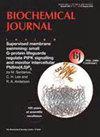Unveiling the role of srbA sRNA in biofilm formation by regulating algU, mucA, rhlA, and rsmA in Pseudomonas aeruginosa.
IF 4.3
3区 生物学
Q2 BIOCHEMISTRY & MOLECULAR BIOLOGY
引用次数: 0
Abstract
The survival and increasing antimicrobial resistance of various bacteria, including clinically relevant opportunistic pathogen, Pseudomonas aeruginosa, largely depends on their biofilm architectural strength, that makes a challenge to eradicate it. Small RNAs (sRNAs) have been identified as the key modulators in regulating the expression and function of different transcriptional regulators, and the components of regulatory networks involved in bacterial biofilm formation. This study was focused to identify the regulatory role of the srbA sRNA in controlling biofilm formation in P. aeruginosa. srbA was found to be upregulated in both substratum-attached and colony biofilms compared to planktonic growth conditions. Further analysis revealed that srbA overexpressing strain produced more biofilm, whereas a significant reduction in biofilm formation was noted due to srbA deletion. Interestingly, it was also predicted from the study that srbA might regulate the expression of AlgU/MucA, the sigma and anti-sigma factor, involved in biofilm developmental network. Additionally, srbA showed possible interference on the expression of two other important biofilm regulatory genes, rhlA and rsmA. Overall, this research highlights the critical role of srbA sRNA as a central regulator of biofilm formation, and possibly the pathogenicity of P. aeruginosa. These findings might offer potential avenues for developing targeted therapeutic strategies to mitigate biofilm-related infections caused by P. aeruginosa.揭示srbA sRNA在铜绿假单胞菌中通过调节algU、mucA、rhlA和rsmA在生物膜形成中的作用。
包括临床相关的机会致病菌铜绿假单胞菌在内的各种细菌的生存和不断增加的抗菌素耐药性在很大程度上取决于它们的生物膜结构强度,这对根除它构成了挑战。小rna (Small rna, sRNAs)被认为是调控不同转录调控因子表达和功能的关键调节剂,也是参与细菌生物膜形成的调控网络的组成部分。本研究旨在确定srbA sRNA在铜绿假单胞菌生物膜形成中的调控作用。与浮游生物生长条件相比,srbA在附着基质和集落生物膜中均被上调。进一步分析表明,srbA过表达菌株产生了更多的生物膜,而srbA缺失导致生物膜形成显著减少。有趣的是,研究还预测srbA可能调控参与生物膜发育网络的sigma和anti-sigma因子AlgU/MucA的表达。此外,srbA还可能干扰另外两个重要的生物膜调控基因rhlA和rsmA的表达。总的来说,本研究强调了srbA sRNA作为生物膜形成的中心调节剂的关键作用,并可能是铜绿假单胞菌的致病性。这些发现可能为开发靶向治疗策略以减轻铜绿假单胞菌引起的生物膜相关感染提供潜在的途径。
本文章由计算机程序翻译,如有差异,请以英文原文为准。
求助全文
约1分钟内获得全文
求助全文
来源期刊

Biochemical Journal
生物-生化与分子生物学
CiteScore
8.00
自引率
0.00%
发文量
255
审稿时长
1 months
期刊介绍:
Exploring the molecular mechanisms that underpin key biological processes, the Biochemical Journal is a leading bioscience journal publishing high-impact scientific research papers and reviews on the latest advances and new mechanistic concepts in the fields of biochemistry, cellular biosciences and molecular biology.
The Journal and its Editorial Board are committed to publishing work that provides a significant advance to current understanding or mechanistic insights; studies that go beyond observational work using in vitro and/or in vivo approaches are welcomed.
Painless publishing:
All papers undergo a rigorous peer review process; however, the Editorial Board is committed to ensuring that, if revisions are recommended, extra experiments not necessary to the paper will not be asked for.
Areas covered in the journal include:
Cell biology
Chemical biology
Energy processes
Gene expression and regulation
Mechanisms of disease
Metabolism
Molecular structure and function
Plant biology
Signalling
 求助内容:
求助内容: 应助结果提醒方式:
应助结果提醒方式:


